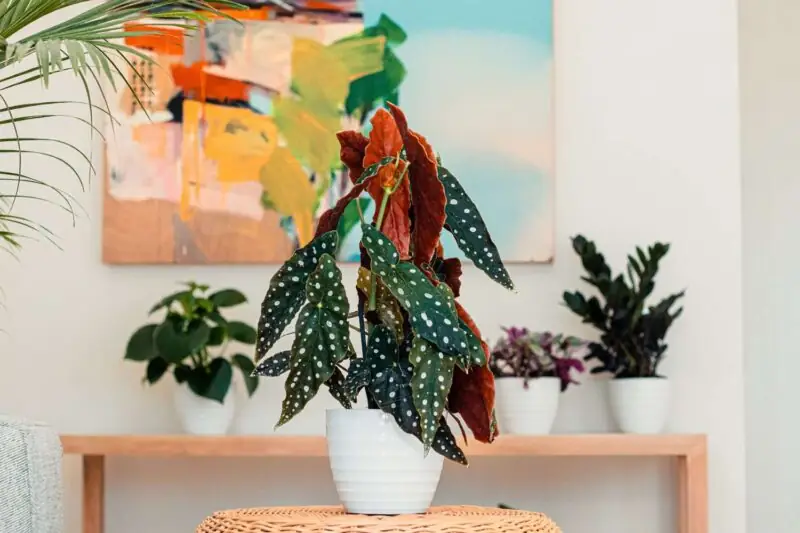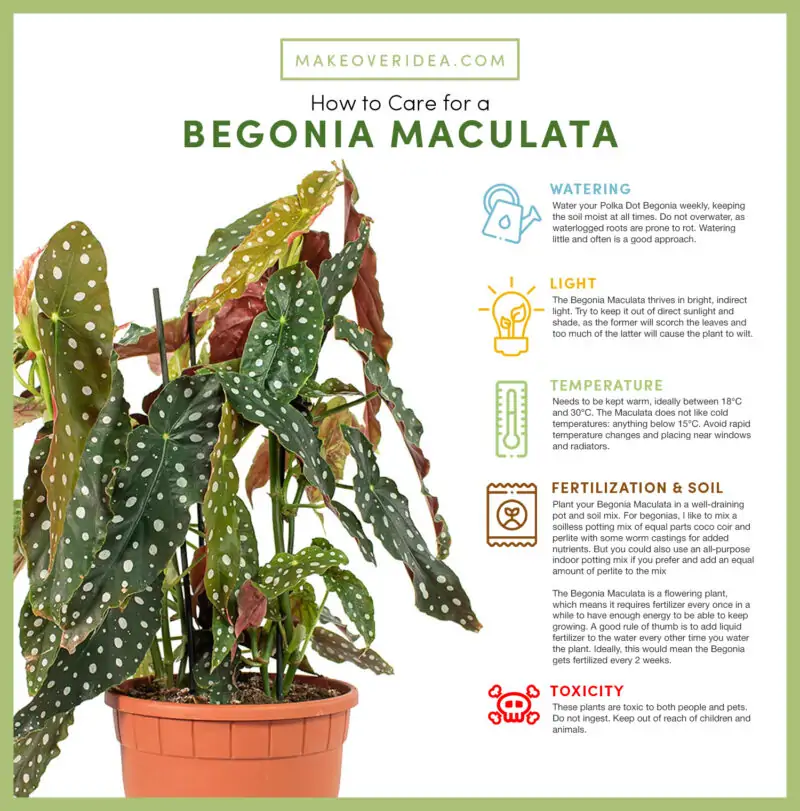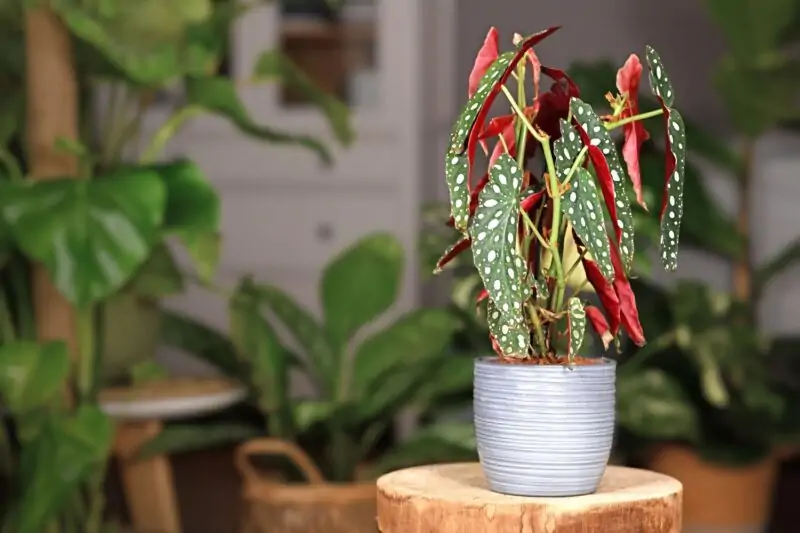Begonia Maculata Care: Guide to Your Polka Dot Begonia

Are you looking for a stunning houseplant that will add life and beauty to your home? Look no further than Begonia Maculata: care for this plant will never be a nuisance. Also known as the Polka Dot Begonia, this plant is prized for its unique foliage, with white polka dots on dark green leaves. Its delicate appearance belies the fact that it’s quite easy to care for if you know what you’re doing.
Read this article to find out how to care for Begonia Maculata: we will cover everything from watering techniques to soil selection and propagation tips so that your Begonia Maculata thrives in any room of your house. Additionally, we’ll discuss common issues such as root rot or bacterial leaf spot so you can prevent them from happening entirely.
But first things first: let’s have an overview of your Spotted Begonia.
Begonia Maculata Care: an Overview
Begonias are a genus of flowering plants consisting mainly of herbaceous perennials native mostly to tropical regions; they belong to the family “Begoniaceae.” One thing they all share is their attractive flowers, which come in various shades, including pink, orange, red, yellow, and many more. However, some varieties, like B. maculate, don’t flower and instead have remarkable foliage. These deep-green lance-like leaves are adorned with silver-white dots, giving rise to the name – Polka Dot Begonias.
These polka dot plants grow quickly, reaching heights of up to 2ft or even beyond under the right conditions. They form bushy mounds packed densely with those delightful spotted leaves, making them a perfect, less demanding indoor specimen compared to other species. They are a great choice for novice gardeners, especially since they are very forgiving when it comes to mistakes such as overwatering or underwatering. They typically bloom during spring and summer months, producing clusters of small white flowers that contrast nicely against the shiny green background.
Let us learn about their origins now.
Origins and Characteristics of Polka Dot Begonia
Polka Dot Begonias originate from Brazil, where these shade-loving plants thrive in rainforests under the canopy of trees, thus adapting to low-light conditions. Begonia Maculata is a distinct begoniaceae species, and its full scientific name is Begonia Masoniana, named after the British plant collector Charles Mason.
The plant has dark green leaves shaped like angel wings, with silver polka dots on them, making it look unique. This variegation occurs naturally but can be further enhanced by exposing plants to bright, indirect sunlight, although too much direct sun will scorch their delicate foliage.
Polka Dot Begonias grow relatively fast, reaching heights of up to 2ft tall or more if allowed to sprawl. You can prune them to keep their size manageable and promote growth. They prefer moist, well-drained soils high in organic matter, containing peat, perlite, or coconut coir.
Next, we’ll explore lighting requirements.

Light Requirements for Begonia Maculatas
Begonia Maculata needs filtered light rather than direct sunlight. Direct sunlight can cause leaf burn, while not enough light leads to long, leggy stems and a lack of foliage and flowers. On the other hand, bright indirect light in a partially shaded environment will help you enjoy healthy, vigorous specimens. An ideal location would be near a north-facing window or a place where your Polka Dot Begonia is shielded from strong afternoon rays.
Dappled shade under larger trees, a porch, or a balcony protected from harsh weather elements are also good options for your house plants. All these places provide gentle breezes and ensure adequate air circulation around the plant. This can be extremely important for maintaining humidity levels in the optimal range of 60-70% relative humidity.
Temperature and Humidity Care Guide

Temperature and moisture are crucial factors for growing any houseplant, including Polka Dot Begonias, because they originate from rainforest habitats characterized by warm temperatures and high humidity. Therefore, striking a balance between temperature and humidity is key to success within indoor environments that mimic similar tropical climates. Moderate warmth, with temperatures ranging from around 16°C at night to no higher than 24°C during the day, and mild winters are ideal. Yearly thermal fluctuations experienced in a typical windowsill position are also beneficial for promoting growth, flowering periods, and survival rate.
If natural environmental conditions aren’t met, adding a humidifier can improve growing conditions for your Polka Dot Begonia, optimize growth potential, and avoid leaf spotting and pests such as spider mites, mealybugs, and whiteflies, which thrive in low moisture environments.
Now let’s talk about watering!
How Often Should I Water My Begonia?
Water is essential when caring for a Begonia Maculata, but overwatering can be detrimental. You want to aim for even soil moisture rather than drowning your plant or letting the roots dry out completely.
The frequency of watering depends on factors like humidity levels, temperature fluctuations, and pot size, with plants in smaller pots generally needing more frequent watering than those housed in larger containers. It’s important to remember to have drainage holes at the bottom of the pot to prevent soggy soils and root rot.
A good rule of thumb is to check the topsoil 1-2 inches below the surface. If it feels moist, wait until it’s drier before the next watering. However, if you’re not confident about how often to water, use a simple trick: stick your finger into the soil up to the middle knuckle, then remove it. If dirt sticks to your finger, indicating dampness, there’s no need to irrigate yet; otherwise, go ahead and hydrate your plant.
Another technique that works well with Begonias involves submerging their entire container in a bowl filled with water, allowing them to soak through, and then letting them drain naturally afterward.
It is also important to say that you should do your best to avoid overwatering your Begonias (as well as all your other houseplants) as this can very quickly result in root rot. The only way of dealing with this condition that works is to cut the affected parts of the root off: while effective, this surgical intervention can also slow down the development of your plant. So, by not letting the roots of your plant be submerged in water for a long time, you actually help your Begonia stay healthy.
Begonia Care: Soil Selection and Composition
Soil selection is vital, as different kinds suit various houseplants, including begonias. The ideal potting mix should provide adequate drainage while retaining enough nutrients to keep your plant healthy, vigorous, and thriving throughout its lifetime.
Therefore, high-quality organic matter mixed with perlite, peat, or coconut coir is the best choice, providing an optimal balance between airiness and moisture retention. These well-draining materials reduce the chances of developing fungal problems such as mildew, powdery mildew, and bacterial leaf spot diseases caused by stagnant sogginess.
Remember, Polka Dot Begonias prefer slightly acidic soil with a pH range of around 6. Adding coffee grounds or a teaspoonful of lime can lower acidity, maintaining a favorable level. Make sure to apply fertilizer regularly.
How to Prune and Fertilize Your Begonia
Pruning and fertilizing are important steps to keep your begonia healthy. Regular pruning helps maintain the shape of the plant, promotes fuller foliage growth, limits leggy stems that produce only a few leaves and prevents disease.
Fertilizing should be done during the spring through summer months using a balanced, water-soluble fertilizer mixed in a dilute solution. This provides essential nutrients, encouraging blooming periods and enhancing overall appearance and health. However, avoid overfeeding or applying too strong a concentration, as this can cause root burn, yellowing leaf tips, or plant death. Follow the manufacturer’s instructions carefully and scale back if you notice any signs of stress.
Prune Polka Dot Begonias regularly, removing dead, dying, or diseased branches to encourage new ones to take their place. Additionally, pinching off soft growing tips is the best way to stimulate bushier, more compact growth. Make sure to cut cleanly using a sharp, sterilized tool.
Propagating Begonia Maculata
Propagation is an excellent way to get more plants from one without having to purchase seeds or clones to start indoors. With proper technique and patience, you can propagate Polka Dot Begonias in several ways, including stem cuttings, layering, division, and even from seed, depending on available resources and preferences.
For example, in propagating by stem-cutting, choose a healthy section 4-6 inches long, remove the lower leaves, dip the cutting in rooting hormone, and then plant it in moist, well-drained soil. Keep the top covered with a plastic bag and mist occasionally until signs of roots emerge.
After about a month, the rooted cutting may be transplanted to a permanent container, where it can mature and continue to thrive under optimal conditions similar to those of the parent plant. https://youtu.be/C6y2L9M-0Lg
Repotting Tips and Techniques
Repotting becomes necessary once your Polka Dot Begonia outgrows its current home or when soil compaction reduces drainage and airflow, affecting the plant’s growth and leading to problems such as poor growth, stunted foliage, or fungal infections.
Therefore, choosing the right pot size is crucial. Always consider the plant’s future needs, selecting a container large enough to hold an additional year or two’s worth of growth while preserving the integrity of the root ball.
Use a sterile, pre-moistened soil mix containing perlite, vermiculite, or coconut coir, and gently loosen the roots of the plant. Make sure to avoid damaging them while transplanting them into the new pot, then water it well.
Pests, Diseases, and Other Common Problems
Polka Dot Begonias are generally healthy plants but can still fall victim to certain pests or diseases. The most common issues include bacterial leaf spots caused by overhead watering or splashing, spider mites that leave telltale white webbing on the undersides of leaves, mealybugs that resemble cotton balls infesting stems and flowers, and fungal infections that cause wilting, yellowing, and loss of vigor.
Unfortunately, if left untreated, these problems may lead to foliage dropping or even the death of the entire plant. Therefore, implementing proper prevention techniques is crucial for avoiding outbreaks altogether. These can include maintaining regular air circulation, removing infected leaves, pruning, sterilizing tools between cuts, and using insecticidal soap or neem oil to treat the early stages of infestations.
Begonia Maculata: Toxic Properties
It’s important to mention here that Polka Dot Begonias contain calcium oxalate crystals in their foliage, making them mildly toxic for pets or humans when ingested in large quantities. This can lead to potential irritation of the mouth, throat, and stomach.
Therefore, it’s recommended to place the plant out of reach of children and pets and to wear gloves when handling it, especially if you have sensitive skin or are prone to allergic reactions.
FAQs
Begonias drop their leaves naturally as they grow older. However, when you notice excessive leaf dropping, it could be due to pests like scales or mite infestations, bacterial or fungal infections, drought stress, environmental changes, or root rot. Check for all of these factors and treat them accordingly.
Observe the foliage quality; there should be no discoloration, yellowing, or browning. Lift up the pot to ensure the roots aren’t rotten. Discard plants with severe pest infestations. Leaves should have symmetrical polka dots on deep green foliage. Watch out for signs of rot or powdery mildew too.
If your plant looks soggy, lift it from the container and check the drainage holes. Unclog them if necessary. Reduce the watering frequency, especially during winter. Trim off affected parts immediately to prevent the disease from spreading, or you may lose the entire plant.
Conclusion
It is really impossible to regret deciding on Begonia Maculate. Care for is houseplant is always easy and following our guide on lighting requirements, fertilization techniques, and soil composition, you will create optimal growing conditions. Remember to avoid over-watering and over-fertilizing, and always use distilled water instead of tap water. Maintain optimal humidity levels for your Begonia Maculata to thrive.
With proper care, your Begonia Maculata will flourish in its new home, adding vibrant character to any room!